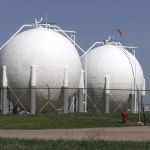 Natural gas was little changed on Tuesday following Mondays sharp gains as investors weighed moderately stronger natural gas demand for cooling across many US regions against a series of larger-than-average inventory builds that would extend current surpluses.
Natural gas was little changed on Tuesday following Mondays sharp gains as investors weighed moderately stronger natural gas demand for cooling across many US regions against a series of larger-than-average inventory builds that would extend current surpluses.
Natural gas for delivery in July traded 0.11% lower at $2.702 per million British thermal units 08:13 GMT, holding in a narrow daily range of $2.716 – $2.696. The contract surged 4.4% on Monday to $2.705 per mBtu, as forecasts trended warmer during the weekend, after settling last week 2% lower which added to the previous two weeks combined decline of 14.5%.
According to NatGasWeather.com, natural gas demand in the US will rise to moderate compared to normal through June 15th, and locally high over the South, with additional warming expected across the countrys southern and eastern regions during the following week.
The eastern, western and southern US will continue to experience highs in the upper 80s to 90s this week, driving moderately strong cooling demand. The Southeast, including Florida, will drive the nation’s strongest natural gas demand as temperatures reach the mid 90s to mid 100s, while California and the interior Pacific Northwest also near the 100s.
The far northern US will remain under the influence of Canadian weather systems tracking through, NatGasWeather.com said, bringing a slight cooling to the Great Lakes and Northeast. Showers and thunderstorms in many regions will keep providing some cooling, but temperatures will overall be higher than last week, leading to a somewhat thinner inventory build to be reported on June 18th.
Overall active weather will continue during the third week of June as well. The eastern, western and southern US will remain very warm to hot as readings hover near the average or several degrees higher, while the north-central US continues to feel the effects of Canadian systems that will keep readings near normal and quite comfortable for the season.
The main focus remains on inconclusive forecasts for the weather developments after June 17th, NatGasWeather.com said. It’s still unclear whether high pressure over the southern and eastern US will hold strong or will give way to approaching Canadian cool blasts, although the first scenario seems to be more likely.
Readings
According to AccuWeather.com, New York will be warmer than usual through June 13th with highs in the lower-mid 80s, compared to the average 78-79, followed by a few-degree cooling the next five days. Chicago will reach 86 degrees Fahrenheit tomorrow, 6 above usual, followed by a drop to 74 degrees on June 13th and a rebound into the low-mid 80s afterwards.
Down South, Houston will peak at 91-92 degrees through June 11th, above the average 90, before easing a few degrees the following seven days. On the West Coast, Los Angeles will reach 85 degrees today, 8 above usual, before easing back to the mid-upper 70s through June 18th.
Inventories
The Energy Information Administration reported last Thursday that US natural gas stockpiles increased by 132 billion cubic feet in the week ended May 29th, surpassing analysts’ median projections for a 121-bcf build. Total gas held in US storage hubs amounted to 2.233 trillion cubic feet, flipping into a surplus of 1.0% to the five-year average of 2.211 trillion from a 0.8% deficit a week earlier. Supplies were also at a surplus of 50.7% to the year-ago inventories of 1.482 trillion.
This week’s report will also reflect a much larger than normal build to expand the surplus further, with initial estimates pointing to a build of around 120 billion cubic feet. The five-year average inventory gain for the week ended June 5th is 89 bcf, while stockpiles rose by 109 bcf a year earlier.
The report after, due out on June 18th, will likely show another above-average build, possibly around 107-108 bcf, but with a smaller gap to the average compared to the previous few reports. The five-year average inventory gain for the week ended June 12th is 87 billion cubic feet, while supplies rose by 112 bcf a year earlier.
Pivot points
According to Binary Tribune’s daily analysis, July natural gas futures’ central pivot point stands at $2.680. In case the contract penetrates the first resistance level at $2.737 per million British thermal units, it will encounter next resistance at $2.768. If breached, upside movement may attempt to advance to $2.825 per mBtu.
If the energy source drops below its S1 level at $2.649 per mBtu, it will next see support at $2.592. In case the second key support zone is breached, the power-station fuel’s downward movement may extend to $2.561 per mBtu.
In weekly terms, the central pivot point is at $2.623. The three key resistance levels are as follows: R1 – $2.691, R2 – $2.791, R3 – $2.859. The three key support levels are: S1 – $2.523, S2 – $2.455, S3 – $2.355.





